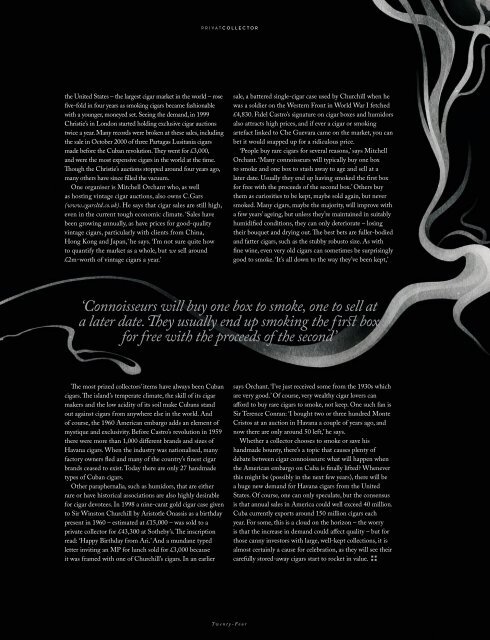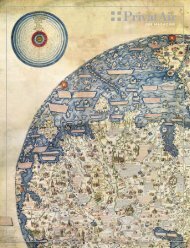january-2012
january-2012
january-2012
You also want an ePaper? Increase the reach of your titles
YUMPU automatically turns print PDFs into web optimized ePapers that Google loves.
the United States – the largest cigar market in the world – rose<br />
fi ve-fold in four years as smoking cigars became fashionable<br />
with a younger, moneyed set. Seeing the demand, in 1999<br />
Christie’s in London started holding exclusive cigar auctions<br />
twice a year. Many records were broken at these sales, including<br />
the sale in October 2000 of three Partagas Lusitania cigars<br />
made before the Cuban revolution. Th ey went for £3,000,<br />
and were the most expensive cigars in the world at the time.<br />
Th ough the Christie’s auctions stopped around four years ago,<br />
many others have since fi lled the vacuum.<br />
One organiser is Mitchell Orchant who, as well<br />
as hosting vintage cigar auctions, also owns C.Gars<br />
(www.cgarsltd.co.uk). He says that cigar sales are still high,<br />
even in the current tough economic climate. ‘Sales have<br />
been growing annually, as have prices for good-quality<br />
vintage cigars, particularly with clients from China,<br />
Hong Kong and Japan,’ he says. ‘I’m not sure quite how<br />
to quantify the market as a whole, but we sell around<br />
£2m-worth of vintage cigars a year.’<br />
Th e most prized collectors’ items have always been Cuban<br />
cigars. Th e island’s temperate climate, the skill of its cigar<br />
makers and the low acidity of its soil make Cubans stand<br />
out against cigars from anywhere else in the world. And<br />
of course, the 1960 American embargo adds an element of<br />
mystique and exclusivity. Before Castro’s revolution in 1959<br />
there were more than 1,000 diff erent brands and sizes of<br />
Havana cigars. When the industry was nationalised, many<br />
factory owners fl ed and many of the country’s fi nest cigar<br />
brands ceased to exist. Today there are only 27 handmade<br />
types of Cuban cigars.<br />
Other paraphernalia, such as humidors, that are either<br />
rare or have historical associations are also highly desirable<br />
for cigar devotees. In 1998 a nine-carat gold cigar case given<br />
to Sir Winston Churchill by Aristotle Onassis as a birthday<br />
present in 1960 – estimated at £15,000 – was sold to a<br />
private collector for £43,300 at Sotheby’s. Th e inscription<br />
read: ‘Happy Birthday from Ari.’ And a mundane typed<br />
letter inviting an MP for lunch sold for £3,000 because<br />
it was framed with one of Churchill’s cigars. In an earlier<br />
PRIVATCOLLECTOR<br />
sale, a battered single-cigar case used by Churchill when he<br />
was a soldier on the Western Front in World War I fetched<br />
£4,830. Fidel Castro’s signature on cigar boxes and humidors<br />
also attracts high prices, and if ever a cigar or smoking<br />
artefact linked to Che Guevara came on the market, you can<br />
bet it would snapped up for a ridiculous price.<br />
‘People buy rare cigars for several reasons,’ says Mitchell<br />
Orchant. ‘Many connoisseurs will typically buy one box<br />
to smoke and one box to stash away to age and sell at a<br />
later date. Usually they end up having smoked the fi rst box<br />
for free with the proceeds of the second box.’ Others buy<br />
them as curiosities to be kept, maybe sold again, but never<br />
smoked. Many cigars, maybe the majority, will improve with<br />
a few years’ ageing, but unless they’re maintained in suitably<br />
humidifi ed conditions, they can only deteriorate – losing<br />
their bouquet and drying out. Th e best bets are fuller-bodied<br />
and fatter cigars, such as the stubby robusto size. As with<br />
fi ne wine, even very old cigars can sometimes be surprisingly<br />
good to smoke. ‘It’s all down to the way they’ve been kept,’<br />
‘Connoisseurs will buy one box to smoke, one to sell at<br />
a later date. Th ey usually end up smoking the first box<br />
for free with the proceeds of the second’<br />
Twenty-Four<br />
says Orchant. ‘I’ve just received some from the 1930s which<br />
are very good.’ Of course, very wealthy cigar lovers can<br />
aff ord to buy rare cigars to smoke, not keep. One such fan is<br />
Sir Terence Conran: ‘I bought two or three hundred Monte<br />
Cristos at an auction in Havana a couple of years ago, and<br />
now there are only around 50 left,’ he says.<br />
Whether a collector chooses to smoke or save his<br />
handmade bounty, there’s a topic that causes plenty of<br />
debate between cigar connoisseurs: what will happen when<br />
the American embargo on Cuba is fi nally lifted? Whenever<br />
this might be (possibly in the next few years), there will be<br />
a huge new demand for Havana cigars from the United<br />
States. Of course, one can only speculate, but the consensus<br />
is that annual sales in America could well exceed 40 million.<br />
Cuba currently exports around 150 million cigars each<br />
year. For some, this is a cloud on the horizon – the worry<br />
is that the increase in demand could aff ect quality – but for<br />
those canny investors with large, well-kept collections, it is<br />
almost certainly a cause for celebration, as they will see their<br />
carefully stored-away cigars start to rocket in value.






